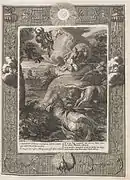| Nerites | |
|---|---|
| Abode | Sea |
| Texts | On the Characteristics of Animals |
| Personal information | |
| Parents | Nereus and Doris |
| Siblings | Nereids |
| Consort | Aphrodite, Poseidon |
In Greek mythology, Nerites (Greek: Νηρίτης, romanized: Nērítēs) was a minor sea deity, the son of "Old Man of the Sea" Nereus and the Oceanid Doris[1] and brother of the fifty Nereids (apparently their only male sibling). He was described as a young boy of stunning beauty. According to Aelian, although Nerites was never mentioned by epic poets such as Homer and Hesiod he was a common figure in the mariners' folklore nevertheless.[2]
Etymology
According to Aristoteles, the name nerites refers to many species of sea snails. R. S. P. Beekes suggests a Pre-Greek origin for the word.[3]
Mythology
Aelian cites two versions of the myth concerning Nerites,[2] which are as follows:
In the first version, Aphrodite, before her ascension from the sea to Olympus, fell in love with Nerites. When the time had come for her to join the Olympian gods, she wanted Nerites to go with her, but he refused, preferring to stay with his family in the sea. Even the fact that Aphrodite promised him a pair of wings did not make him change his mind. The scorned goddess then transformed him into a shellfish and gave the wings to her son Eros.
In the second version, Nerites was loved by Poseidon and answered his feelings. Their love was the origin of mutual love (Anteros). Poseidon also made Nerites his charioteer; the boy drove the chariot astonishingly fast, to the admiration of various sea creatures. The sun god Helios, for reasons unknown to Aelian's sources, changed Nerites into a shellfish; the narrative of the love-story is disrupted by Helios who is resentful of the boy's speed, but with no explanation behind it, allowing Aelian to conjecture that the two gods were rivals in love and Helios might have wanted the boy's affections for himself and was offended by his refusal.[4]
Iconography
In the nineteenth century several terracotta figurines from the Greek island of Aegina were identified by the German archaeologist Karl Bernhard Stark as artistic representations of Aphrodite with Nerites.[5][6]
See also
Notes
- ↑ Grimal, s.v. Nerites, p. 308.
- 1 2 Aelian, De Natura Animalium 14.28.
- ↑ Beekes, p. 1017.
- ↑ Sanders et al. 2013, p. 86.
- ↑ Wagner 1898, s.v. Nerites.
- ↑ Stark 1865, pp. 71-80.
References
- Claudius Aelianus, On the Characteristics of Animals, translated by Alwyn Faber Scholfield (1884-1969), from Aelian, Characteristics of Animals, published in three volumes by Harvard/Heinemann, Loeb Classical Library, 1958. Online version at the Topos Text Project.
- Beekes, Robert S. P., Etymological Dictionary of Greek, 2 vols, Leiden, Brill, 2009. ISBN 978-90-04-17418-4. Online version at Brill.
- Grimal, Pierre, The Dictionary of Classical Mythology, Wiley-Blackwell, 1996. ISBN 978-0-631-20102-1. Internet Archive.
- Sanders, Ed; Thumiger, Chiara; Carey, Christopher; Lowe, Nick J. (2013). Erôs in Ancient Greece. Oxford University Press. ISBN 978-0-19-960550-7.
- Stark, Karl Bernhard (1865). "Aphrodite Pontia und Nerites, Terracotta aus Aegina". Archäologische Zeitung (in German) (200). Retrieved November 12, 2023.
- Wagner, Richard (1898). "Nerites". In Wilhelm Heinrich Roscher (ed.). Ausführliches Lexikon der griechischen und römischen Mythologie [Detailed dictionary of Greek and Roman mythology] (in German). Vol. III. Leipzig: Teubner-Verlag.
.jpg.webp)
.jpg.webp)
